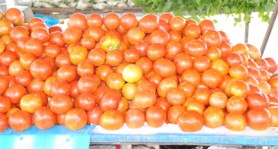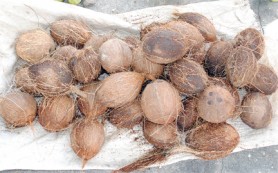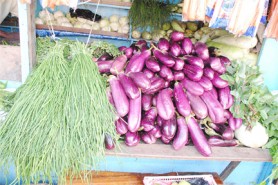Bad weather during the second quarter of this year severely reduced production levels for several categories of food crops which, coupled with a high percentage of spoilage in some cases forced the prices of several high-demand food crops up, according to the Ministry of Agriculture’s June 2010 Commodity Market Report.

And while the report says that inclement weather and other factors resulted in price hikes on the local market for several crops, it asserts, nonetheless, that farmers are moving towards planting more crops that target export markets. Farmers, the report say, are now benefiting from more support from the Ministry of Agriculture through the purchase of additional trucks for cold storage, training, seed distribution, marketing support, and increased access to micro credit schemes.
According to the report, overall, the prices of vegetables, fruits, root crops and seasonings all rose, in some instances significantly during the second quarter of 2010. The price of tomatoes rose by around 137% between April and June this year, compared with the January – March period. The steep rise in tomato price over the last quarter is attributed to reduced supplies resulting from contaminated seeds and attendant curling of leaves and fruits “appearing to be diseased.” Other vegetables for which consumers were generally required to pay more during the second quarter of this year were pumpkin, ochro, same and pakchoy.

The prices of several fruits were also higher during the second quarter of the year with the Ministry of Agriculture report naming dried coconuts, mangoes and oranges as fruits that fetched higher prices between April and June. The hike in the price of coconuts is attributed both to the rainy season and to the continued demand for the commodity in overseas markets. According to the report the prices of pineapples, limes, passion fruit, watermelons and plantains reduced over the last quarter while the supply of pineapples, plantains and watermelons increased significantly as a result of increased planting to meet the export market.
During the second quarter of the year, the prices of several categories of root crops including yams, sweet potatoes, ginger and eddoes rose in price. Ginger recorded a 64.2% price hike, the highest among root crops. The report attributes the significant rise in the price of ginger to the effects of El Nino farms in the Region One area. Eddo farmers at Kuru Kuru, one of the major areas in the country for the cultivation of the crop were also affected by the same weather pattern. “On the other hand cassava production continued to increase significantly and as such was the only root crop whose price reduced during the second quarter,” the report said.

The second quarter of 2010 saw price increases for all seasons as compared with the first quarter of the year with eschallot recording a 71.8% increase in price. Rainy weather resulted in a fluctuation in the supply of both pepper and eschallot during the April – June period.
Meanwhile, according to the report, total timber and plywood production increased by 11% between January and June this year, compared with the same period last year. Plywood production jumped by 42% while the volume of logs produced increased by 18.61% over 2009 production for the same period. Other timber products such as sawn wood and round wood fell by 7.96% and 19.45%, respectively. Both logs and plywood performed well on the export market with export sales of the former increasing by 173.44% and the latter by 39.31% during the first half of this year. However, exports of other wood products, including sandalwood and roundwood declined in volume.
India and China continued to be the major destinations for Guyana’s wood exports, with India accounting for 29,862m3 and China accounting for 22,106m3. Other significant timber markets were found in Suriname and Trinidad & Tobago, while the single largest overseas market for Guyana’s sawn wood was the Netherlands. Barbados also represents a significant market for Guyana’s sawn wood.
According to the report, over the review period, total export value for timber and plywood rose by 29.48% for the first six months of 2009 while the total export value secured from all forest products jumped by 23.89%. Over the period, total earnings from log exports increased by 154% while plywood exports increased by 40% compared with the same period last year. Sawn wood remained the highest export revenue earner in the local forestry sector with export sales reaching around US$10.6 million for the first half of 2010. Total export sales of logs during the same period reached US$6.4 million, while plywood exports raked in US$2.6 million.





